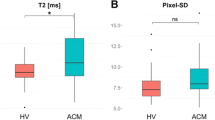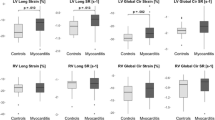Abstract
Objectives
To re-evaluate a recently suggested approach of quantifying myocardial oedema and increased tissue inhomogeneity in myocarditis by T2-mapping.
Methods
Cardiac magnetic resonance data of 99 patients with myocarditis were retrospectively analysed. Thirthy healthy volunteers served as controls. T2-mapping data were acquired at 1.5 T using a gradient-spin-echo T2-mapping sequence. T2-maps were segmented according to the 16-segments AHA-model. Segmental T2-values, segmental pixel-standard deviation (SD) and the derived parameters maxT2, maxSD and madSD were analysed and compared to the established Lake Louise criteria (LLC).
Results
A re-estimation of logistic regression models revealed that all models containing an SD-parameter were superior to any model containing global myocardial T2. Using a combined cut-off of 1.8 ms for madSD + 68 ms for maxT2 resulted in a diagnostic sensitivity of 75% and specificity of 80% and showed a similar diagnostic performance compared to LLC in receiver-operating-curve analyses. Combining madSD, maxT2 and late gadolinium enhancement (LGE) in a model resulted in a superior diagnostic performance compared to LLC (sensitivity 93%, specificity 83%).
Conclusions
The results show that the novel T2-mapping-derived parameters exhibit an additional diagnostic value over LGE with the inherent potential to overcome the current limitations of T2-mapping.
Key Points
• A novel quantitative approach to myocardial oedema imaging in myocarditis was re-evaluated.
• The T2-mapping-derived parameters maxT2 and madSD were compared to traditional Lake-Louise criteria.
• Using maxT2 and madSD with dedicated cut-offs performs similarly to Lake-Louise criteria.
• Adding maxT2 and madSD to LGE results in further increased diagnostic performance.
• This novel approach has the potential to overcome the limitations of T2-mapping.




Similar content being viewed by others
Abbreviations
- AIC:
-
Akaike information criterion
- AUC:
-
Area under the curve
- BSA:
-
Body surface area
- bSSFP:
-
Balanced steady-state free-precession
- CAD:
-
Coronary artery disease
- CMR:
-
Cardiovascular magnetic resonance
- ECG:
-
Electrocardiogram
- ED:
-
End diastolic
- EF:
-
Ejection fraction
- EGEr:
-
Early gadolinium enhancement ratio
- EMB:
-
Endomyocardial biopsy
- ES:
-
End systolic
- FA:
-
Flip angle
- GraSE:
-
Gradient Spin Echo T2 mapping sequence
- IQR:
-
Interquartile range
- LGE:
-
Late gadolinium enhancement
- LLC:
-
Lake Louise criteria
- LV:
-
Left ventricle
- MAD:
-
Mean absolute deviation
- madSD:
-
MAD of segmental pixel-SD values
- madlSD:
-
Loge-transformed version of madSD
- madT2:
-
MAD of segmental T2 values
- maxSD:
-
Maximum segmental pixel-SD value
- maxT2:
-
Maximum segmental T2 value
- MLE:
-
Maximum likelihood estimator
- Pixel-SD:
-
Segmental pixel-standard deviation of T2 values
- ROC:
-
Receiver operating curve
- ROI:
-
Region of interest
- SAX:
-
Short axis
- SD:
-
Standard deviation
- T:
-
Tesla
- T2 BB:
-
T2 black blood
- TE:
-
Echo time
- TnT:
-
Troponin T
- TR:
-
Repetition time
References
Greulich S, Ferreira VM, Dall'Armellina E, Mahrholdt H (2015) Myocardial inflammation-are we there yet? Curr Cardiovasc Imaging Rep. doi:10.1007/s12410-015-9320-6
Park CH, Choi E-Y, Greiser A et al (2013) Diagnosis of acute global myocarditis using cardiac MRI with quantitative t1 and t2 mapping: case report and literature review. Korean J Radiol. doi:10.3348/kjr.2013.14.5.727
Friedrich MG, Sechtem U, Schulz-Menger J et al (2009) Cardiovascular magnetic resonance in myocarditis: a JACC white paper. J Am Coll Cardiol. doi:10.1016/j.jacc.2009.02.007
Francone M, Chimenti C, Galea N et al (2014) CMR sensitivity varies with clinical presentation and extent of cell necrosis in biopsy-proven acute myocarditis. J Am Coll Cardiol Img. doi:10.1016/j.jcmg.2013.10.011
Ferreira VM, Piechnik SK, Dall'Armellina E et al (2012) Non-contrast T1-mapping detects acute myocardial edema with high diagnostic accuracy: a comparison to T2-weighted cardiovascular magnetic resonance. J Cardiovasc Magn Reson. doi:10.1186/1532-429X-14-42
Thavendiranathan P, Walls M, Giri S et al (2012) Improved detection of myocardial involvement in acute inflammatory cardiomyopathies using T2 mapping. Circ Cardiovasc Imaging. doi:10.1161/CIRCIMAGING.111.967836
Giri S, Chung Y-C, Merchant A et al (2009) T2 quantification for improved detection of myocardial edema. J Cardiovasc Magn Reson. doi:10.1186/1532-429X-11-56
Hamlin SA, Henry TS, Little BP et al (2014) Mapping the future of cardiac MR imaging: case-based review of T1 and T2 mapping techniques. Radiographics. doi:10.1148/rg.346140030
Baeßler B, Schaarschmidt F, Stehning C et al (2015) A systematic evaluation of three different cardiac T2-mapping sequences at 1.5 and 3T in healthy volunteers. Eur J Radiol. doi:10.1016/j.ejrad.2015.08.002
Wassmuth R, Prothmann M, Utz W et al (2013) Variability and homogeneity of cardiovascular magnetic resonance myocardial T2-mapping in volunteers compared to patients with edema. J Cardiovasc Magn Reson. doi:10.1186/1532-429X-15-27
Radunski UK, Bohnen S, Lund G et al (2015) T1 and T2 mapping CMR to quantify focal myocardial injury in patients with myocarditis. J Cardiovasc Magn Reson. doi:10.1186/1532-429X-17-S1-O90
Butler CR, Savu A, Bakal JA et al (2015) Correlation of cardiovascular MRI findings and endomyocardial biopsy results in patients undergoing screening for heart transplant rejection. J Heart Lung Transplant. doi:10.1016/j.healun.2014.12.020
Baeßler B, Schaarschmidt F, Dick A et al (2015) Mapping tissue inhomogeneity in acute myocarditis: a novel analytical approach to quantitative myocardial edema imaging by T2-mapping. J Cardiovasc Magn Reson. doi:10.1186/s12968-015-0217-y
Caforio ALP, Pankuweit S, Arbustini E et al (2013) Current state of knowledge on aetiology, diagnosis, management, and therapy of myocarditis: a position statement of the European Society of Cardiology Working Group on Myocardial and Pericardial Diseases. Eur Heart J. doi:10.1093/eurheartj/eht210
Simonetti OP, Finn JP, White RD et al (1996) “Black blood” T2-weighted inversion-recovery MR imaging of the heart. Radiology. doi:10.1148/radiology.199.1.8633172
Friedrich MGM, Strohm OO, Schulz-Menger JJ et al (1998) Contrast media-enhanced magnetic resonance imaging visualizes myocardial changes in the course of viral myocarditis. Circulation. doi:10.1161/01.CIR.97.18.1802
Kramer CM, Barkhausen J, Flamm SD et al (2008) Standardized cardiovascular magnetic resonance imaging (CMR) protocols, society for cardiovascular magnetic resonance: board of trustees task force on standardized protocols. J Cardiovasc Magn Reson. doi:10.1186/1532-429X-10-35
Baeßler B, Schaarschmidt F, Stehning C et al (2015) Cardiac T2-mapping using a fast gradient echo spin echo sequence - first in vitro and in vivo experience. J Cardiovasc Magn Reson. doi:10.1186/s12968-015-0177-2
Abdel-Aty H, Boyé P, Zagrosek A et al (2005) Diagnostic performance of cardiovascular magnetic resonance in patients with suspected acute myocarditis: comparison of different approaches. J Am Coll Cardiol. doi:10.1016/j.jacc.2004.11.069
Friedrich MG, Marcotte F (2013) Cardiac magnetic resonance assessment of myocarditis. Circ Cardiovasc Imaging. doi:10.1161/CIRCIMAGING.113.000416
Cerqueira MD, Verani MS, Schwaiger M et al (1994) Safety profile of adenosine stress perfusion imaging: results from the Adenoscan Multicenter Trial Registry. J Am Coll Cardiol. doi:10.1016/0735-1097(94)90424-3
R Core Team (2008) R: a language and environment for statistical computing. R Foundation for Statistical Computing. Available via http://www.R-project.org/. Accessed 08 March 2017
Wickham H, Chang W (2016) ggplot2: an implementation of the Grammar of Graphics. Available via http://ggplot2.tidyverse.org. Accessed 08 March 2017.
Grosjean P, Ibanez F, Etienne M (2002) Pastecs: package for analysis of space-time ecological series. Available via http://www.sciviews.org/pastecs. Accessed 08 March 2017
Maindonald JH, Braun WJ (2015) DAAG: data analysis and graphics data and functions. Available via http://www.stats.uwo.ca/DAAG. Accessed 08 March 2017
Liaw A, Wiener M, Breiman L, Cutler A (2015) randomForest: Breiman and Cutler's random forests for classification and regression. Available via https://www.stat.berkeley.edu/~breiman/RandomForests/. Accessed 08 March 2017
Therneau T, Atkinson B, Ripley B (2015) Recursive partitioning and regression trees. Available via http://www.R-project.org/. Accessed 08 March 2017
Breiman L, Friedman J, Stone CJ, Olshen RA (1984) Classification and regression trees, 1st edn. Chapman and Hall/CRC, Belmont
Sing T, Sander O, Beerenwinkel N, Lengauer T (2015) ROCR: visualizing the performance of scoring classifiers. Available via http://rocr.bioinf.mpi-sb.mpg.de/. Accessed 08 March 2017
Gutberlet M, Lücke C, Krieghoff C et al (2013) [MRI for myocarditis]. Radiologe. doi:10.1007/s00117-012-2385-1
Radunski UK, Lund GK, Stehning C et al (2014) CMR in patients with severe myocarditis: diagnostic value of quantitative tissue markers including extracellular volume imaging. J Am Coll Cardiol Img. doi:10.1016/j.jcmg.2014.02.005
Lurz P, Luecke C, Eitel I et al (2016) Comprehensive cardiac magnetic resonance imaging in patients with suspected myocarditis: the MyoRacer-Trial. J Am Coll Cardiol. doi:10.1016/j.jacc.2016.02.013
Moon JC, Messroghli DR, Kellman P et al (2013) Myocardial T1 mapping and extracellular volume quantification: a Society for Cardiovascular Magnetic Resonance (SCMR) and CMR Working Group of the European Society of Cardiology consensus statement. J Cardiovasc Magn Reson. doi:10.1186/1532-429X-15-92
Hinojar R, Foote L, Arroyo Ucar E et al (2015) Native T1 in discrimination of acute and convalescent stages in patients with clinical diagnosis of myocarditis: a proposed diagnostic algorithm using CMR. J Am Coll Cardiol Img. doi:10.1016/j.jcmg.2014.07.016
Ferreira VM, Piechnik SK, Dall'Armellina E et al (2013) T1 mapping for the diagnosis of acute myocarditis using CMR: comparison to T2-weighted and late gadolinium enhanced imaging. J Am Coll Cardiol Img. doi:10.1016/j.jcmg.2013.03.008
Luetkens JA, Doerner J, Thomas DK et al (2014) Acute myocarditis: multiparametric cardiac MR imaging. Radiology. doi:10.1148/radiol.14132540
Ferreira VM, Piechnik SK, Dall'Armellina E et al (2014) Native T1-mapping detects the location, extent and patterns of acute myocarditis without the need for gadolinium contrast agents. J Cardiovasc Magn Reson. doi:10.1186/1532-429X-16-36
Luetkens JA, Homsi R, Sprinkart AM et al (2015) Incremental value of quantitative CMR including parametric mapping for the diagnosis of acute myocarditis. Eur Heart J Cardiovasc Imaging. doi:10.1093/ehjci/jev246
Baeßler B, Schaarschmidt F, Dick A et al (2016) Diagnostic implications of magnetic resonance feature tracking derived myocardial strain parameters in acute myocarditis. Eur J Radiol. doi:10.1016/j.ejrad.2015.11.023
Cooper LT, Baughman KL, Feldman AM et al (2007) The role of endomyocardial biopsy in the management of cardiovascular disease: a scientific statement from the American Heart Association, the American College of Cardiology, and the European Society of Cardiology Endorsed by the Heart Failure Society of America and the Heart Failure Association of the European Society of Cardiology. Eur Heart J. doi:10.1093/eurheartj/ehm456
Author information
Authors and Affiliations
Corresponding author
Ethics declarations
Guarantor
The scientific guarantor of this publication is Dr. Bettina Baeßler.
Conflict of interest
The authors of this manuscript declare relationships with the following companies: Dr. Stehning and Dr. Schnackenburg are employees of Philips Research and Philips Healthcare, respectively.
Funding
The authors state that this work has not received any funding.
Statistics and biometry
Dr. Frank Schaarschmidt kindly provided statistical advice for this manuscript.
Informed consent
Written informed consent was obtained from all healthy volunteers in this study.
Written informed consent for the patients was waived by the Institutional Review Board due to the retrospective nature of the patient study.
Ethical approval
Institutional Review Board approval was obtained.
Study subjects or cohorts overlap
Some study subjects or cohorts have been previously reported in Baeßler B, Schaarschmidt F, Dick A, et al (2015) Mapping tissue inhomogeneity in acute myocarditis: a novel analytical approach to quantitative myocardial enema imaging by T2-mapping. J Cardiovasc Magn Reson: Official Journal of the Society for Cardiovascular Magnetic Resonance 17:115. doi: 10.1186/s12968-015-0217-y.
Methodology
• retrospective
• diagnostic or prognostic study
• performed at one institution
Electronic supplementary material
Below is the link to the electronic supplementary material.
ESM 1
(DOCX 199 kb)
Rights and permissions
About this article
Cite this article
Baeßler, B., Schaarschmidt, F., Treutlein, M. et al. Re-evaluation of a novel approach for quantitative myocardial oedema detection by analysing tissue inhomogeneity in acute myocarditis using T2-mapping. Eur Radiol 27, 5169–5178 (2017). https://doi.org/10.1007/s00330-017-4894-9
Received:
Revised:
Accepted:
Published:
Issue Date:
DOI: https://doi.org/10.1007/s00330-017-4894-9




